Why replace your pickleball grip?
The importance of maintaining a reliable grip cannot be overstated in the world of pickleball. Regularly replacing your grip unlocks several significant benefits that can elevate your game. It’s about more than just aesthetics; the right grip enhances functionality and comfort, making every match an enjoyable experience.
- Improved Comfort: A new grip can make your paddle feel like an extension of your arm, reducing strain during long matches.
- Enhanced Control: A well-fitted grip allows for better maneuverability, enabling you to execute precise shots under pressure.
- Better Sweat Absorption: Quality grips absorb sweat effectively, maintaining their tackiness and keeping your paddle secure even during the most intense rallies.
- Increased Tackiness: A fresh grip brings back that all-important stickiness, ensuring you don’t lose hold of your paddle during pivotal moments.
- Preventing Slipping: This is crucial for accuracy; you won’t have to worry about the paddle slipping from your hand as you swing.
- Extended Paddle Life: Regularly replacing grips prolongs the lifespan of your paddle by preventing damage to the handle.
Regular grip replacement is akin to a gardener tending to their plants both require attention to flourish. Just as a well-cultivated plant can bear beautiful flowers and provide shade, a well-maintained grip ensures that your paddle is always ready to perform at its best.
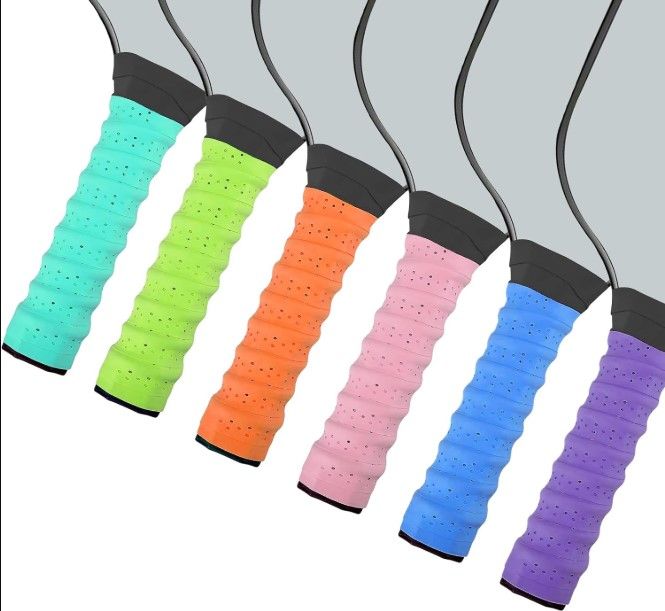
Types of pickleball grips: Choosing the right fit for you
Choosing the right type of grip is essential for maximizing your performance on the court. The primary options to consider are replacement grips and overgrips. Each serves a unique purpose and caters to different player preferences and styles.
Replacement grips
Replacement grips are designed to replace the original grip of your paddle, offering a fresh start with thicker cushioning. Their thickness provides a comfortable touch, much like a plush carpet that changes the way you navigate a room. Ideal scenarios for using a replacement grip include:
- Worn-out original grip: If your existing grip has seen better days, it’s time for a replacement.
- Desire for a different feel or size: A thicker or softer replacement grip can lead to a more enjoyable playing experience.
Replacement grips enhance your experience by serving as a foundation of comfort, ensuring every shot feels just right. They cradle your hand, allowing you to focus solely on your game.
Overgrips
Overgrips are thinner and are meant to be added over the existing grip. They enhance tackiness without significantly altering the paddle's feel. This makes them similar to a well-fitted glove, providing an added layer without bulk. Situations where overgrips shine include:
- Adding tackiness to an existing grip: If you find your grip lacks traction, an overgrip can provide the necessary extra security.
- Slightly increasing grip size: If you're looking for a little extra thickness, overgrips do this without a full replacement.
Overgrips offer a quick solution for adjusting the feel of your paddle without the extensive commitment that comes with a complete grip replacement.
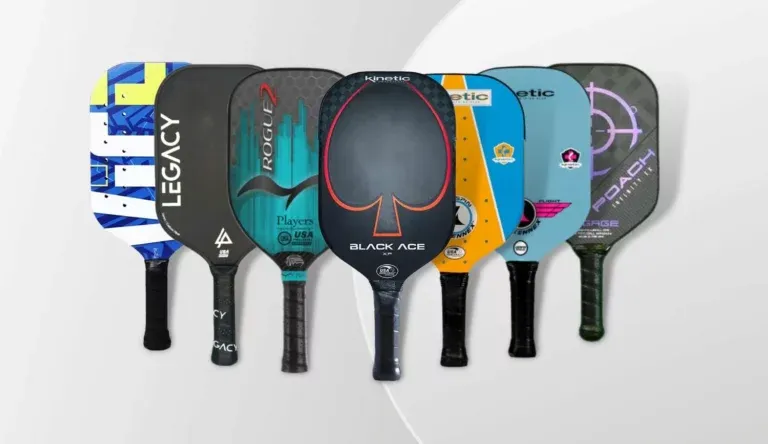
Grip size: Finding your perfect match
Selecting the right grip size is foundational to achieving optimal performance. A grip that is too small or too large can lead to discomfort, hinder control, and ultimately affect shot accuracy.
First, measuring your hand circumference is crucial. Follow this step-by-step guide:
- Using a flexible measuring tape: Wrap it around the widest part of your palm.
- Read the measurement: This number in inches or centimeters will guide your selection.
Generally, the following table correlates hand circumference measurements to recommended grip sizes:
| Hand Circumference (inches) | Recommended Grip Size |
|---|---|
| 3.5 - 3.75 | Size 4 (Small) |
| 3.75 - 4 | Size 4.5 (Medium) |
| 4 - 4.25 | Size 5 (Large) |
| 4.25 - 4.5 | Size 5.5 (Extra Large) |
Finding the right grip size is about ensuring that your hand feels secure. Like a key fitting perfectly into a lock, the right grip enhances your control over the paddle and your overall gameplay.
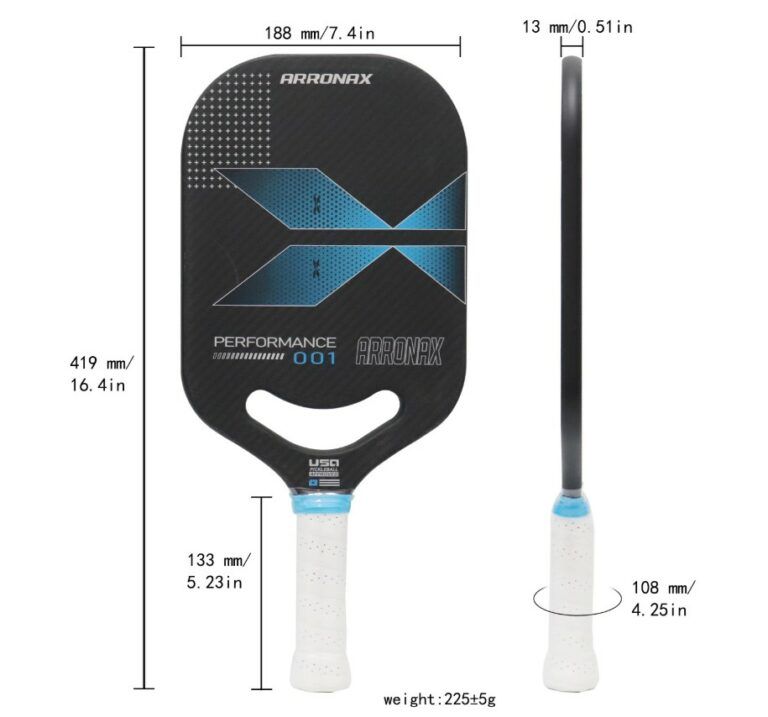
Grip materials: The science behind the feel
Understanding the materials that compose pickleball grips is essential in choosing the one that feels best for your playing style. The common types of grip materials include rubber, synthetic, and leather, each bringing unique benefits and drawbacks.
Rubber grips
Rubber grips are known for their excellent tackiness and durability. They provide a solid hold, much like the reliable grip of a well-crafted hammer. Pros include:
- Tackiness: High friction ensures a secure hold.
- Moisture absorption: Good for sweaty conditions.
However, they can sometimes have a firmer feel, which may not suit some players' preferences.
Synthetic grips
Synthetic grips are typically softer and more adaptable, offering a different feel compared to rubber. They perform well under various playing conditions. Comparing them to rubber grips, synthetic grips advantageously provide:
- Soft touch: Making them feel comfortable in hand.
- Durability: Many synthetic options hold up well over time.
Nevertheless, they may lack the same level of tackiness as rubber, potentially impacting grip security.
Leather grips
Leather grips offer a classic, high-end feel. They welcome you with a sensation akin to fine wine; the more you use them, the better they get. Benefits of leather grips include:
- Durability: Leather ages well with proper care.
- Sophisticated feel: Professional players often prefer leather for its tactile comfort.
They do require more maintenance and may not offer as much moisture-wicking capability compared to synthetic or rubber options. This makes them particularly suited for players seeking longevity and a luxurious touch.
Tools and materials: Gathering your grip-changing arsenal
To replace a pickleball grip effectively, having the right tools and materials ensures a smooth process. Prepare your arsenal for a seamless transition with the following essentials:
- Replacement grip or overgrip: Choose according to your needs.
- Sharp scissors or utility knife: For cutting tape and trimming excess.
- Finishing tape (or electrical tape): To secure the grip in place.
- Rubbing alcohol (for cleaning): Essential for removing old adhesive residue.
- Optional: Build-up tape may be used to enhance grip size and comfort.
With these tools, much like a chef preparing ingredients, you’ll be ready to mix and match the elements that fit you best.
How to replace pickleball paddle grip?
Getting rid of your old grip is a crucial first step in replacing it. To do this successfully, you need to understand how to handle your equipment carefully.
Removing a replacement grip
Carefully cutting the old replacement grip is the way to start. Utilizing a utility knife, make a gentle incision along the material, being cautious not to damage the paddle handle underneath. Just as a sculptor carefully chisels away the stone to reveal a masterpiece, you should exercise patience to unveil your paddle’s pristine state.
Safety Note: Handle sharp tools meticulously, as injuries can occur.
Removing an overgrip
Removing an old overgrip follows a similar procedure. Peel away from one end and work your way to the other. Take your time, as the sticky remnants of the overgrip might resist your efforts, but with persistence, your new grip awaits.
Preparing the paddle handle: Creating a clean slate
Once the old grip is gone, ensuring that your paddle handle is clean and devoid of residue is crucial for optimal adhesion.
Cleaning the handle
Use rubbing alcohol or a cloth to wipe down the handle thoroughly. Remove any leftover adhesive, ensuring a secure hold for the new grip. A clean handle is essential, as it promotes efficient adhesion, much like the way a painter prepares a canvas before creating a stunning work of art.
Using build-up tape (optional)
If you prefer a thicker grip or are customizing for better comfort, build-up tape can be a beneficial addition. Wrap it around the handle before applying the new grip, ensuring it creates the desired thickness and feel.
Applying the new grip: A step-by-step guide to a secure hold
With the old grip gone and the handle cleaned, it’s time for the most satisfying part: applying the new grip!
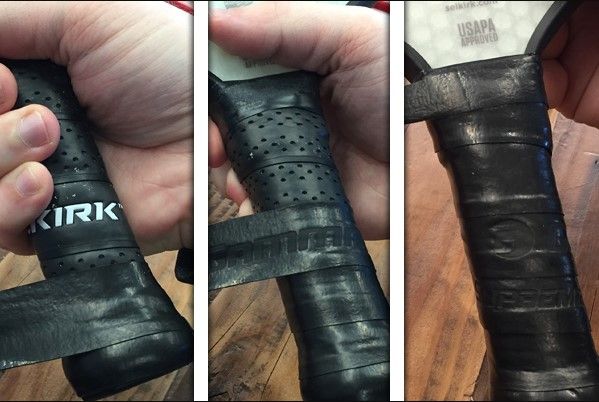
Starting the wrap
Begin by positioning the tapered end of the grip at the base of the paddle handle. For right-handed players, align it to the left, while left-handers should align to the right. This is like the foundation of a building; set it up right, and the rest will follow smoothly!
Overlapping and tension
As you begin wrapping, maintain a slight stretch on the tape to eliminate wrinkles. Ensure each layer overlaps the previous one by about 1/8 inch, creating seamless coverage. This attention to detail is akin to a tailor measuring fabric to ensure a perfectly fitted suit.
Working your way up
Gently but firmly work your way up the handle, following its contours. Ensure the grip remains taut but not overly stretched, allowing it to mold to the shape of your hand.
Securing the top
Once you reach the top, cut away any excess material. Secure the end with the provided finishing or electrical tape, making sure everything feels snug. Your paddle should now be as ready as you are to hit the court!
Grip styles and their impact on your game
The style of grip you choose can have a significant impact on your gameplay. Understanding these differences is crucial for optimizing your playstyle.
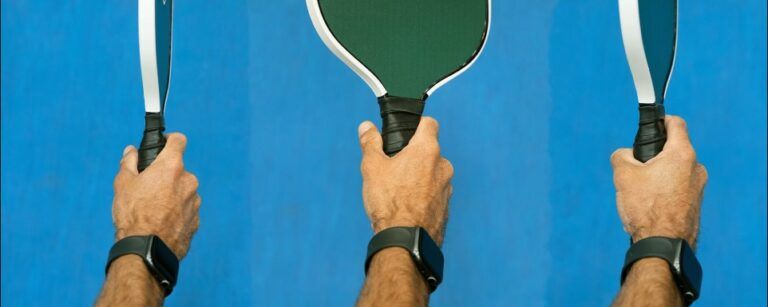
The continental grip
The continental grip is often regarded as the foundation of a solid pickleball game. It provides versatility, enabling effective serves and volleys. Its biggest advantage lies in its adaptability, allowing for quick adjustments during gameplay.
The eastern grip
This grip allows players to generate more control over their shots. It excels at both forehand and backhand strokes, providing benefits such as added topspin. However, it may not be the best choice for those seeking power in each shot.
The western grip
Offering an advanced style for skilled players, the western grip allows for significant spin and power. Its unique positioning favors aggressive play but can be more challenging for newcomers to master.
Understanding grip styles is like knowing the strengths and weaknesses of your opponent. It prepares you to strategize and make the best moves on the court.
Troubleshooting and tips: Solving common grip issues
Even with the best intentions, issues can arise. With our troubleshooting tips, you can avoid potential pitfalls in grip replacement.
Wrinkles: Causes and solutions
Wrinkles in your grip can detract from both comfort and performance. Common causes include not applying enough tension or not overlapping adequately. To remedy this, carefully peel back the grip and reapply it with even pressure to smooth things out.
Uneven grip: Achieving consistency
An uneven grip can affect your confidence when handling the paddle. Ensure that each layer overlaps evenly and that you maintain consistent tension during the application. If necessary, take it slow and provide the care your grip deserves.
Loose ends: Securing for the long haul
Grip ends might become loose over time, but you can prevent this. Use finishing or electrical tape to secure the ends tightly. Much like ensuring the cap is secure on your favorite beverage, taking this precaution helps keep your grip in pristine condition.
Grip maintenance: Keeping that fresh grip feeling
Maintaining your new grip is essential for longevity and performance. Regular care can keep the grip looking and feeling fresh over time.
Cleaning your grip
Regularly cleaning your grip is crucial for maintaining its tackiness. Use a mild soap solution and avoid harsh chemicals that can wear down materials. Like washing your hands, a little cleanliness can go a long way.
Proper storage
Store your paddle in a cool, dry place, avoiding direct sunlight or extreme temperatures that could damage the grip material. Proper storage ensures that your grip remains preserved and ready for action at any time.
Expert insights: Tips from the pros
Professional players and coaches have invaluable insights when it comes to grip selection and maintenance. According to Sarah Johnson, a well-regarded coach and player, “The right grip can completely change your game. Don’t just replace it choose it based on what you need for your playing style.”
Additionally, many players emphasize the importance of familiarity with your grip. The more comfortable you are with it, the better you’ll perform, much like an actor who knows their script by heart.
Popular grips: Reviews and comparisons
To help you navigate the sea of grip options available, let’s review some popular brands of pickleball grips.
Gamma grips
Gamma produces a variety of high-quality grips. Their Gamma Pro model is especially popular for its tackiness and durability. Users praise its comfortable feel and excellent moisture control.
ProLite grips
ProLite is another favorite, offering grips that are well-balanced for various playing styles. Their ProLite Classic grip is noted for its excellent shock absorption and feel.
Other notable brands
As new brands enter the market, options such as Extreme and Head are garnering attention for their innovation in grip technology. Comparing characteristics like tackiness and durability will help you make a well-informed choice.
Conclusion
In summary, replacing your pickleball paddle grip is not just about practicality it's about enhancing your game and bringing confidence to the court. By understanding the importance of grip material, size, and style, you can make informed decisions that suit your personal preferences and playing style. Remember, a well-maintained grip is the secret ingredient to elevating your pickleball experience. Now, take the knowledge you've gained and experiment until you find the grip that allows you to express your true potential on the court. With the right grip, who knows how far you can go?










